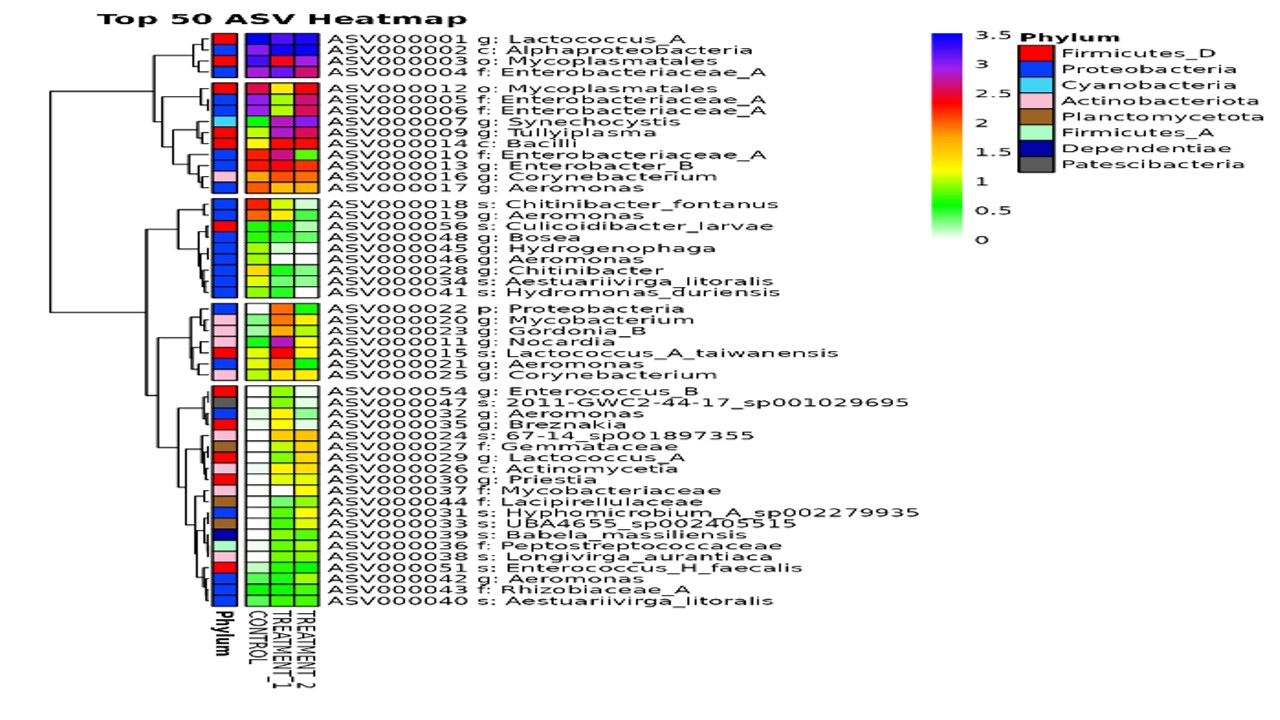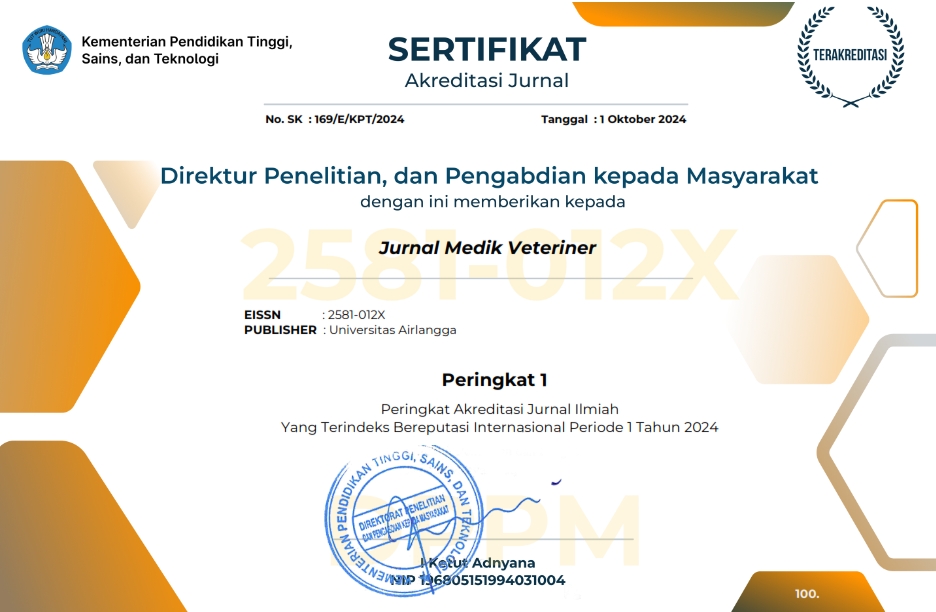Dietary Chlorella vulgaris Improves Growth and Modulates Gut Microbiota in Giant Freshwater Prawn (Macrobrachium rosenbergii)

Downloads
The giant freshwater prawn (Macrobrachium rosenbergii) is a commercially vital species in global aquaculture due to its rapid growth and high market demand, and Chlorella vulgaris is a nutrient-rich microalga lauded for its potential as a sustainable feed supplement. In this preliminary study, the effects of C. vulgaris supplementation on the growth and gut microbiota of giant freshwater prawn was investigated. Prawns were randomly assigned to three groups and fed diets supplemented with C. vulgaris at 0 g/kg (control), 30 g/kg (T1), or 60 g/kg (T2) for 14 days. For growth performance analysis, body weight was measured in a randomly selected 10% of the population at the beginning, midpoint, and end of the experiment. For gut microbiota analysis, faecal samples were taken from M. rosenbergii and used for DNA extraction and amplification via PCR. The PCR product was sequenced using 16S rRNA sequencing on Illumina platform. Results showed significantly improved growth rates in the supplemented groups, with T2 (highest growth rate) having 55% higher weight gain compared to the controls. Gut microbiota analysis revealed increased diversity, with the alpha biodiversity indices showing higher indices in supplemented groups compared to the controls although non-significant (p = 0.196, 0.136, 0.532 and 0.304 for Ace Chao1, Shannon and Simpson respectively). Specifically, the T1 group (highest alpha biodiversity) exhibited the following increases compared to the control: Ace by 53.55%, Shannon by 61.16%, Chao1 by 55.94%, and Simpson by 55.90%. In β-biodiversity analysis, there were shifts in bacterial community composition, with a notable increase in beneficial bacteria such as Synechocystis spp. and decrease in potentially pathogenic ones such as Chitinibacter spp. in the supplemented groups. PICRUSt2 analysis predicted enhanced metabolic pathways related to vitamin synthesis and energy metabolism, suggesting improved gut health and nutrient utilization. Although some results lacked statistical significance due to the short study duration, the findings suggest that long-term C. vulgaris supplementation may yield more pronounced benefits in M. rosenbergii aquaculture, potentially improving growth performance.
Ahmmed, M. K., Bhowmik, S., Ahmmed, F., Giteru, S. G., Islam, S. S., Hachem, M., Hussain, M. A., Kanwugu, O. N., Agyei, D., & Defoirdt, T. (2023). Utilisation of probiotics for disease management in giant freshwater prawn (Macrobrachium rosenbergii): Administration methods, antagonistic effects and immune response. Journal of Fish Diseases, 46(12), 1321–1336.
Aigner, S., Glaser, K., Arc, E., Holzinger, A., Schletter, M., Karsten, U., & Kranner, I. (2020). Adaptation to Aquatic and Terrestrial Environments in Chlorella vulgaris (Chlorophyta). Frontiers in microbiology, 11, 585836.
Ajiboye, O. O., Yakubu, A. F., & Adams, T. E. (2012). A perspective on the ingestion and nutritional effects of feed additives in farmed fish species. World Journal of Fish and Marine Sciences 4, 87–101.
An, T., Cai, Y., & Li, G. (2023). Prevalence and transmission risk of colistin and multidrug resistance in long-distance coastal aquaculture. Isme Communication, 3, 115.
Angeles, I. P., Chien, Y., & Tayamen, M. M. (2009). Effects of different dosages of astaxanthin on giant freshwater prawn Macrobrachium rosenbergii (De Man) challenged with Lactococcus garvieae. Aquaculture Research, 41(1), 70–77.
AOAC. (2016). Official Methods of Analysis of Association of Official Analytical Chemists, 20th edition. Rockville, MD.
Badwy, T. M., Ibrahim, E. M., Zeinhom, M. M., Elghobashy, H., Fitzsimmons, K., & Diabeditors, A. S. (2013). English, Conference paper, USA, Corvallis, From the pharaohs to the future. Eighth International Symposium on Tilapia in Aquaculture. Proceedings. Cairo, Egypt, 12–14 October 2008, 801–811.
Bolyen, E., Rideout, J. R., Dillon, M. R., Bokulich, N. A., Abnet, C. C., Al-Ghalith, G. A., Alexander, H., Alm, E. J., Arumugam, M., Asnicar, F., Bai, Y., Bisanz, J. E., Bittinger, K., Brejnrod, A., Brislawn, C. J., Brown, C. T., Callahan, B. J., Caraballo-Rodríguez, A. M., Chase, J., & Caporaso, J. G. (2019). Reproducible, interactive, scalable and extensible microbiome data science using QIIME 2. Nature Biotechnology, 37(8), 852–857.
Callahan, B. J., Benjamin J., Paul, J., McMurdie, K., Michael, J., Rosen, S., Andrew, W., Han, A., Jo, A., Johnson, J., & Susan, P. H. (2016). DADA2: High-Resolution Sample Inference from Illumina Amplicon Data. Nature Methods, 13(7), 581–83.
Chen, S., Yanqing, Z., Yaru, C., & Jia, G. (2018). Fastp: An Ultra-Fast All-in-One FASTQ Preprocessor. Bioinformatics, 34(17), i884–90.
Chong, J., Peng, L., Guangyan, Z., & Jianguo, X. (2020). Using Microbiome Analyst for Comprehensive Statistical, Functional, and Meta-Analysis of Microbiome Data. Nature Protocols, 15(3), 799–821.
Darbyshire, A. K., Oliver, K. H., Dupont, W. D., Plummer, W. D., Jones, C. P., & Boyd, K. L. (2019). Anesthesia and Euthanasia of Brine Shrimp (Artemia franciscana). Journal of American Association Laboratory Animal Science, 58(1), 58–64.
De Souza, G. L. E., De Brito, K. C. T., Kobayashi, R. K. T., Nakazato, G., Cavalli, L. S., Otutumi, L. K., & De Brito, B. G. (2020). Antimicrobials and resistant bacteria in global fish farming and the possible risk for public health. Arquivos Do Instituto Biológico, 87(1), 23.
Department of Fisheries (DOF). (2023). Annual Fisheries Statistics – Volume 1. pp: 22.
Douglas, A., Gavin, M., Vincent, J., Maffei, A., Jesse, R., Zaneveld, N., Svetlana, N., Yurgel, A., James R., Brown, C., Christopher, M., Taylor, M., Curtis, H., & Morgan, G. I. (2020). PICRUSt2 for Prediction of Metagenome Functions. Nature Biotechnology, 38(6), 685–88.
Eissa, E. S. H., Aljarari, R. M., & Elfeky, A. (2023). Protective effects of Chlorella vulgaris as a feed additive on growth performance, immunity, histopathology, and disease resistance against Vibrio parahaemolyticus in the Pacific white shrimp. Aquaculture International, 32, 2821–2840.
Fikri, F., Wardhana, D. K., Purnomo, A., Khairani, S., Chhetri, S., & Purnama, M. T. E. (2022). Aerolysin gene characterization and antimicrobial resistance profile of Aeromonas hydrophila isolated from milkfish (Chanos chanos) in Gresik, Indonesia. Veterinary World, 15(7), 1759–1764.
Friedman, A., Jonathan, F., & Eric, J. (2012). Inferring Correlation Networks from Genomic Survey Data. PLOS Computational Biology, 8(9), e1002687.
Gao, Q., Huang, H., Liu, P., Zhao, X., Tang, Q., Xia, Z., Cai, M., Wang, R., Huang, G., & Yi, S. (2024). Integration of Gut Microbiota with Transcriptomic and Metabolomic Profiling Reveals Growth Differences in Male Giant River Prawns (Macrobrachium rosenbergii). Animals, 14(17), 2539.
García-López, R., Fernanda, C. G., Alonso, A., Lopez, Z., Filiberto, S. L., Andrés, C. H., Rogerio, R. S. M., Abraham, G., Alfredo, M. V., Bruno, G. G., & Adrian, O. L. (2020). Doing More with Less: A Comparison of 16S Hypervariable Regions in Search of Defining the Shrimp Microbiota. Microorganisms, 8(1), 134.
Gavin, A., Huttley, A., & Gregory, C. (2018). Optimizing Taxonomic Classification of Marker Gene Amplicon Sequences with QIIME 2’s Q2-Feature-Classifier Plugin. Microbiome, 6(1), 90.
Glenn, F., Travis, C., Todd, W., Pierson, S., Natalia, J., Bayona-Vásquez, A., Troy, J., Kieran, G., Sandra, L., Hoffberg, D., Jesse, C., Thomas, I. V., Daniel, E., & Lefever, A. (2019). Adapterama II: Universal Amplicon Sequencing on Illumina Platforms (TaggiMatrix). PeerJ, 7 (10), e7786.
Hickey, C. W. (2013). Updating nitrate toxicity effects on freshwater aquatic species. National Institute of Water & Atmospheric Research Ltd, Hamilton, New Zealand.
Hoang, M. N., Nguyen, P. N., & Bossier, P. (2020). Water quality, animal performance, nutrient budgets and microbial community in the biofloc-based polyculture system of white shrimp, Litopenaeus vannamei and gray mullet, Mugil cephalus. Aquaculture, 515, 734610.
Huang, Z., Gao, J., Peng, C., Song, J., Xie, Z., Jia, J., Li, H., Zhao, S., Liang, Y., & Gong, B. (2023). The Effect of the Microalgae Chlorella vulgaris on the Gut Microbiota of Juvenile Nile Tilapia (Oreochromis niloticus) Is Feeding-Time Dependent. Microorganisms, 11(4), 1002.
Kader, M. A., Zahidah Azahar, N., Iehata, S., Bulbul, M., Islam, M. M., Sarker, J., Mariom, N., Rahman, M. M., & Asaduzzaman, M. (2021). Dietary supplementation of host‐associated lactic acid bacteria modulates growth, metabolic activities, and immune‐related gene expression in giant freshwater prawn, Macrobrachium rosenbergii. Journal of the World Aquaculture Society, 52(1), 216–230.
Kela, E. (2022). Significance of immunostimulants in aquaculture: a review. Journal of Aquaculture and Fish, 6, 046.
Khani, M., Soltani, M., Mehrjan, M. S., Foroudi, F., & Ghaeni, M. (2017). The effect of Chlorella vulgaris (Chlorophyta, Volvocales) microalga on some hematological and immune system parameters of Koi carp (Cyprinus carpio). Iranian Journal of Ichthyology, 4(1), 62–68.
Klindworth, A., Elmar, P., Timmy, S., Jörg, P., Christian, Q., Matthias, H., & Frank, O. G. (2013). Evaluation of General 16S Ribosomal RNA Gene PCR Primers for Classical and Next-Generation Sequencing-Based Diversity Studies. Nucleic Acids Research, 41(1), e1–e1.
Lan, X., Peng, X., Du, T., Xia, Z., Gao, Q., Tang, Q., Yi, S., & Yang, G. (2023). Alterations of the Gut Microbiota and Metabolomics Associated with the Different Growth Performances of Macrobrachium rosenbergii Families. Animals, 13(9), 1539.
Liang, T., Li, X., Du, J., Yao, W., Sun, G., Dong, X., Liu, Z., Ou, J., Meng, Q., Gu, W., & Wang, W. (2011). Identification and isolation of a Spiroplasma pathogen from diseased freshwater prawns, Macrobrachium rosenbergii, in China: A new freshwater crustacean host. Aquaculture, 318(1–2), 1–6.
Liu, A., Santigosa, E., Dumas, A., & Hernandez, J. M. (2022). Vitamin nutrition in salmonid aquaculture: From avoiding deficiencies to enhancing functionalities. Aquaculture, 561, 738654.
Liu, M., Sun, C., Zhou, Q., Xu, P., Wang, A., Zheng, X., & Liu, B. (2024). Supplementation of Yupingfeng polysaccharides in low fishmeal diets enhances intestinal health through influencing the intestinal barrier, immunity, and microflora in Macrobrachium rosenbergii. Frontiers in Immunology, 15, 1480897.
Maliwat, G. C. F., Velasquez, S. F., Buluran, S. M. D., Tayamen, M. M., & Ragaza, J. A. (2020). Growth and immune response of pond-reared giant freshwater prawn Macrobrachium rosenbergii post larvae fed diets containing Chlorella vulgaris. Aquaculture and Fisheries, 12(1), 23.
Maliwat, G. C., Velasquez, S., Robil, J. L., Chan, M., Traifalgar, R. F., Tayamen, M., & Ragaza, J. A. (2016). Growth and immune response of giant freshwater prawn Macrobrachium rosenbergii (De Man) postlarvae fed diets containing Chlorella vulgaris (Beijerinck). Aquaculture Research, 48(4), 1666–1676.
Mallasen, M., & Valenti, W. C. (2006). Effect of nitrite on larval development of giant river prawn Macrobrachium rosenbergii. Aquaculture, 261(4), 1292–1298.
Martin, M. (2011). Cutadapt Removes Adapter Sequences from High-Throughput Sequencing Reads. EMBnet.Journal, 17(1), 10–12.
McDonald, D., Jiang, Y., & Balaban, M. (2023). Greengenes-2 unifies microbial data in a single reference tree. Nat Biotechnol, 20(3), 12.
Medagoda, N., & Kyeong, L. J. (2025). Vitamin B 12 is essential for growth, innate immunity, antioxidant capacity, fatty acid and amino acid metabolism and ammonia tolerance in Pacific white shrimp, Penaeus vannamei. Research Square, 12(1), 48.
Motta, J. H. S., Santos, L. C., Dutra, F. M., Souza, A. B., Polese, M. F., Glória, L. S., Oliveira, A. P., & Ballester, E. L. C. (2024). Acute toxicity of total ammonia to Macrobrachium rosenbergii postlarvae at different salinity levels. Brazilian Journal of Biology, 84, e276323.
Ondov, A., Brian, D., Nicholas, H., Bergman, B., & Adam, M. (2011). Interactive Metagenomic Visualization in a Web Browser. BMC Bioinformatics, 12(1), 385.
Panahi, Y., Yari, K. A., Sahebkar, A., & Heidari, H. R. (2019). Impact of Cultivation Condition and Media Content on Chlorella vulgaris Composition. Advanced Pharmaceutical Bulletin, 9(2), 182–194.
Parks, D. H., Gene, W. T., Philip, H., & Robert, G. B. (2014). STAMP: Statistical Analysis of Taxonomic and Functional Profiles. Bioinformatics, 30(21), 3123–24.
Pepi, M., & Focardi, S. (2021). Antibiotic-Resistant Bacteria in Aquaculture and Climate Change: A Challenge for Health in the Mediterranean Area. International Journal of Environmental Research and Public Health, 18(11), 5723.
Phuong, N. T., Hai, T. N., Hien, T. T. T., Van Bui, T., Huong, D. T. T., Son, V. N., Morooka, Y., Fukuda, Y., & Wilder, M. N. (2006). Current status of freshwater prawn culture in Vietnam and the development and transfer of seed production technology. Fish Science, 72, 1–12.
Pillai, B. R., & Panda, D. (2024). Global Status of Giant Prawn, Macrobrachium rosenbergii Farming with Special Reference to India and Measures for Enhancing Production. Journal of Aquaculture, 12(1), 01–14.
Pillai, B. R., Ponzoni, R. W., Das Mahapatra, K., & Panda, D. (2022). Genetic improvement of giant freshwater prawn Macrobrachium rosenbergii: A review of global status. Reviews in Aquaculture, 14(3), 1285–1299.
Prakash, M., & Karmagam, N. (2013). A study on bacterial flora associated with fresh water prawn, Macrobrachium rosenbergii. International Journal of Current Research and Academic Review, 1(1), 1–16.
Rahimnejad, S., & Lee, S. M. (2016). Effects of dietary inclusion of Chlorella vulgaris on growth, blood biochemical parameters, and antioxidant enzyme activity in olive flounder, Par-alichthys olivaceus. Journal of the World Aquaculture Society, 47, 309–458.
Sahoo, P. K., Das, A., Mohanty, S., Mohanty, B. R., Pillai, B. R., & Mohanty, J. (2008). Dietary β-1,3-glucan improves the immunity and disease resistance of freshwater prawn Macrobrachium rosenbergii challenged with Aeromonas hydrophila. Aquaculture Research, 39, 1574–1578.
Segata, N., Jacques, I., Levi, W., Dirk, G., Larisa, M., Wendy, S., Garrett, A., & Curtis, H. (2011). Metagenomic Biomarker Discovery and Explanation. Genome Biology, 12(6), R60.
Shiau, S. Y., & Chin, Y. H. (1998). Dietary biotin requirement for maximum growth of juvenile grass shrimp, Penaeus monodon. The Journal of Nutrition, 128(12), 2494–2497.
Shiau, S. Y., & Liu, J. S. (1994). Estimation of the dietary vitamin K requirement of juvenile Penaeus chinensis using menadione. Aquaculture, 126(1–2), 129–135.
Sukri, S., Saad, C., Kamarudin, M., & Yasin, I. (2016). Effect of different levels of Chlorella meal on growth and survival of freshwater prawns Macrobrachium rosenbergii juvenile. Songklanakarin Journal of Science Technology, 38, 641–644.
Xu, H., Ren, J., Xu, X., Lou, B., & Zhang, D. (2023). The Composition and Diversity of Intestinal Microbes at Different Growth Stages of Giant Freshwater Prawns (Macrobrachium rosenbergii). Fishes, 8(9), 473.
Yuan, H., Song, W., Tan, J., Zheng, Y., Wang, H., Shi, L., & Zhang, S. (2023). The Effects of Dietary Protein Level on the Growth Performance, Body Composition, Intestinal Digestion and Microbiota of Litopenaeus vannamei Fed Chlorella sorokiniana as the Main Protein Source. Animals, 13(18), 2881.
Yuan, H., Xie, M., Chen, J., Hu, N., Wang, H., Tan, B., Shi, L., & Zhang, S. (2024). Combined intestinal microbiota and transcriptomic analysis to investigate the effect of different stocking densities on the ability of Pacific white shrimp (Litopenaeus vannamei) to utilize Chlorella sorokiniana. Animal Nutrition, 18, 203–219.
Zhai, Y., Shi, D., He, P., Cai, C., Yin, R., & Jia, R. (2019). Effect of trans-vp28 gene Synechocystis sp. PCC6803 on growth and immunity of Litopenaeus vannamei and defense against white spot syndrome virus (WSSV). Aquaculture, 512, 734306.
Zhang, S., & Sun, X. (2022). Core gut microbiota of shrimp function as a regulator to maintain immune homeostasis in response to WSSV infection. Microbiology Spectrum, 10(2), e02465.
Zhao, Y., Duan, C., Zhang, X., Chen, H., Ren, H., Yin, Y., & Ye, L. (2018). Insights into the Gut Microbiota of Freshwater Shrimp and Its Associations with the Surrounding Microbiota and Environmental Factors. Journal of Microbiology and Biotechnology, 28(6), 946–956.
Zhi, X., Yao, J., Tang, S., Huang, Y., Li, H., & Li, W. (2014). The Futalosine Pathway Played an Important Role in Menaquinone Biosynthesis during Early Prokaryote Evolution. Genome Biology and Evolution, 6(1), 149–160.
Copyright (c) 2025 Ammar Norazman, Nur Diyana Mohamad Tahir, Annas Salleh, Norhariani Mohd Nor, Mohamad Noor Amal Azmai, Natrah Ikhsan

This work is licensed under a Creative Commons Attribution-NonCommercial-ShareAlike 4.0 International License.
Authors who publish in this journal agree to the following terms:
1. The journal allows the author to hold the copyright of the article without restrictions;
2. The journal allows the author(s) to retain publishing rights without restrictions;
3. The legal formal aspect of journal publication accessibility refers to Creative Commons Attribution-NonCommercial-ShareAlike 4.0 International License (CC BY-NC-SA).






11.jpg)




















